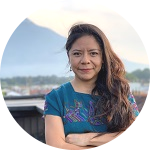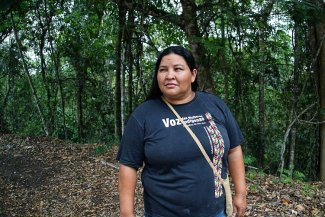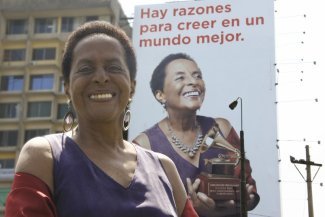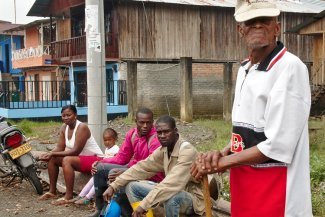We sail across the clear waters of the Bay of All Saints in the direction of Praia Grande on Ilha de Maré. This island in the state of Bahia in northeastern Brazil is home to a ‘quilombola’ fishing community, or a rural settlement founded by descendants of enslaved people. Before arriving, we are welcomed by two large chimneys belching thick, black smoke. Selma Jesús de Souza, a powerful woman of 60, waits for us on the shore.
Selma deferentially greets the members of her community that we come across on our walk. Rather than a leader, she describes herself as a “social counsellor” for her community. She is also an educator and master’s student at the nursing school of the Federal University of Bahia. She was the first quilombola woman to study there.

Selma Jesús de Souza, a ‘quilombola’ woman, at a plantation in Praia Grande, located on Ilha de Maré in the state of Bahia in northeastern Brazil.
In Brazil, the term ‘quilombo’ refers to rural hinterland communities whose members are descended from African slaves. The term is also associated with a centuries-long history of collective resistance to the oppressive legacy of slavery. The Brazilian state granted the quilombos their own legal status in 1988 in an attempt to guarantee ownership of the land on which these communities live, but progress has been slow and conflicts over land rights continue to persist.

An estimated 16 million Brazilians live in conditions of poverty in the quilombola territories. The communities of Ilha de Maré are taking action to ensure a better future for their young people.
According to official data from a 2019 report by the Inter-American Commission on Human rights (IACHR), people of African descent represent 56.8 per cent of Brazil’s roughly 213 million inhabitants.

Selma Jesús de Souza shows us the fibre panels that are ready for sale.
Selma shows us the site where her community manufactures soundproofing panels made from wild cane fibre, which is also used for the construction of walls. Initiated in 2009 with the support of the non-profit organisation SOMMAR, this community work project brings social, environmental and quality-of-life improvements to her village and territory.

Cane fibre waste on the shore of Praia Grande. Behind it are boats belonging to local residents.
The idea for these ecological panels came from an academic study by Professor Célia Grahem of the Federal University of Maringá in the state of Paraná. On visiting Ilha Maré, Grahem realised the potential of using the wild cane waste discarded by the island’s artisans. The panels provide acoustic insulation and improve sound quality in theatres, auditoriums and restaurants. Improving room acoustics has a positive impact on the health of education professionals.

A resident of Praia Grande displays his handicrafts during a public holiday on the island. Several families in the region augment their income with artisanal work.
The moment we set foot on the island, the main economic activities of its residents become immediately evident – one is fishing and shell fishing; the other the production of wild cane baskets for a variety of uses. The livelihoods of fishers, however, are being threatened by petrochemical companies in the port of Aratu, located to the east and a 25-minute boat ride from Praia Grande.

Selma Jesús de Souza in the office. The poster behind her reads: “There is a history of black people without Brazil, but there is no history of Brazil without black people.”
Sitting on the couch in the office under posters highlighting messages of resistance, Selma explains that social and community groups have faced neglect and violations of basic constitutionally guaranteed rights in recent years, for instance, to be able to live under dignified and just conditions. Selma and other quilombola women like her are helping to create economic incentives and encourage new generations to keep their economy alive by caring for the environment. In the face of adversity, they have a very important tool: creativity. Women are at the forefront of every activity that benefits the community.

In the workshop, Selma shows us the processed cane fibre used for making the panels.
This ecological panel project is one of many examples. It was the women who organised the construction of the workshop where the panels are produced. With limited space and little available machinery, they produce 22 panels a day. This is far from their ideal target, but the best they can hope for without additional investment support.
We move through the island’s thick vegetation and intense heat, passing through several of Praia Grande’s neighbourhoods. For many years now, local schools have had vegetable gardens for self-consumption. Several groups of women gather together in their neighbourhoods to work for a better future for the next generation. The ‘Yabás’ project currently under development will for instance provide training and tools for citizen empowerment. The project – which derives its name from the Yoruba phrase for ‘Queen Mother’ – is aimed at the children and adolescents of Ilha de Maré.

Two young boys play on the main pier of Praia Grande on a public holiday.
Selma also participates in projects with women, adolescents and children that focus on community health and well-being. “Local women are in charge of leading and implementing all of the social activities,” Selma proudly says. Not long ago, she initiated a handbag-making course to provide other women in the community with a means of earning additional income to supplement traditional work such as shell fishing, which requires significant effort and carries long-term health consequences.
As a direct effect of the pollution, Selma explains, some fruits such as bananas and mangoes can no longer be found in the territory. These fruits used to be produced on the island and taken to the mainland for sale at the markets. As we walk along dry roads by the seashore, Selma explains to us that the infertility of the soil is linked to the pollution generated by the port of Aratu and its chemical activities. Gas emissions accompanied by a very strong odour are also frequent.

Panoramic view of Praia Grande, Ilha de Maré, from the boat shortly before arrival. Two large chimneys and numerous industrial warehouses stand out on the shore.
Speaking by telephone, another Ilha de Maré leader – who did not want to be identified due to the threats she has received for her activism – explains that the number of people with cancer has increased over recent years and resulted in a series of deaths. She attributes the rise in cancer cases and deaths to the emission of pollutants from the chemical and petrochemical companies in the Bay of All Saints.
Through their daily actions, these women are weaving a resilient web of resistance. This is like “ants’ work”, Selma explains, entailing a significant amount of effort to juggle the various initiatives.















